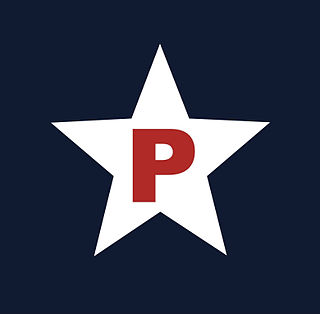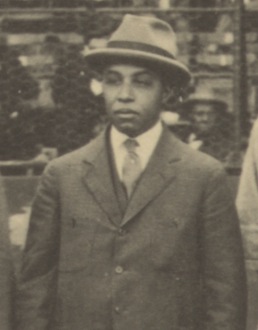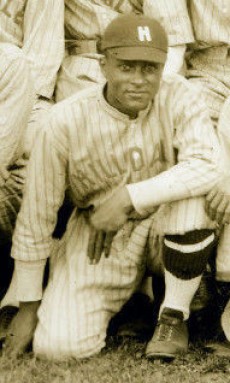The Negro leagues were United States professional baseball leagues comprising teams of African Americans. The term may be used broadly to include professional black teams outside the leagues and it may be used narrowly for the seven relatively successful leagues beginning in 1920 that are sometimes termed "Negro Major Leagues".

The Mutual Association of Eastern Colored Clubs, more commonly known as the Eastern Colored League (ECL), was one of the several Negro leagues, which operated during the time organized baseball was segregated.
The American Negro League (ANL) was one of several Negro leagues established during the period in the United States in which organized baseball was segregated. The ANL operated on the East Coast of the United States in 1929.

William Julius "Judy" Johnson was an American professional third baseman and manager whose career in Negro league baseball spanned 17 seasons, from 1921 to 1937. Slight of build, Johnson never developed as a power threat but achieved his greatest success as a contact hitter and an intuitive defenseman. Johnson is regarded as one of the greatest third basemen of the Negro leagues. In 1975, he was elected into the Baseball Hall of Fame after being nominated by the Negro Leagues Committee.

James Raleigh "Biz" Mackey was an American catcher and manager in Negro league baseball. He played for the Indianapolis ABCs (1920–1922), New York Lincoln Giants (1920), Hilldale Daisies (1923–1931), Philadelphia Royal Giants (1925), Philadelphia Stars (1933–1935), Washington / Baltimore Elite Giants (1936–1939), and Newark Dodgers/Eagles.

Louis Santop Loftin was an American baseball catcher in the Negro leagues. He became "one of the earliest superstars" and "black baseball's first legitimate home-run slugger" (Riley), and was elected to the Baseball Hall of Fame in 2006. Some sources show a birth year of 1890, but his Navy records and Baseball Hall of Fame records support the earlier date.

The Philadelphia Stars were a Negro league baseball team from Philadelphia. The Stars were founded in 1933 when Ed Bolden returned to professional black baseball after being idle since early 1930. The Stars were an independent ball club in 1933, a member of the Negro National League from 1934 until the League's collapse following the 1948 season, and affiliated with the Negro American League from 1949 to 1952.
The Indianapolis ABCs were a Negro league baseball team that played both as an independent club and as a charter member of the first Negro National League (NNL). They claimed the western championship of black baseball in 1915 and 1916, and finished second in the 1922 NNL. Among their best players were Baseball Hall of Fame members Oscar Charleston, Biz Mackey, and Ben Taylor.
The Philadelphia Giants were a Negro league baseball team that played from 1902 to 1911. From 1904 to 1909 they were one of the strongest teams in black baseball, winning five eastern championships in six years. The team was organized by Sol White, Walter Schlichter, and Harry Smith.
The 1924 Colored World Series was a best-of-nine match-up between the Negro National League champion Kansas City Monarchs and the Eastern Colored League champion Hilldale. In a ten-game series, the Monarchs narrowly defeated Hilldale 5 games to 4, with one tie game. It was the first World Series between the respective champions of the NNL and ECL. It was the second year of existence for the ECL, but no agreement could be reached in 1923 for a postseason series, owing primarily to unresolved disputes between the leagues. Five members of the Baseball Hall of Fame participated in the series: Biz Mackey, Judy Johnson, and Louis Santop played for Hilldale, while Bullet Rogan and José Méndez played for the Monarchs. In addition, Monarchs owner J. L. Wilkinson was also inducted into the Hall.
Hilldale Park was a ballpark in Darby, Pennsylvania at the northeast corner of Chester and Cedar Avenues. It was the home field of the Hilldale Club professional baseball team which played in the Negro leagues between 1910 and 1932. The ballpark opened in 1914. It had a well-manicured field with a large tree in center-field, whose branches overlooked the field and were considered in play.

Phillip "Fish" Cockrell, born Philip Cockrell Williams, was a baseball player in the Negro leagues.

Edward Bolden was an American baseball executive and owner in the Negro leagues.

Paul Eugene "Country Jake" Stephens was an American baseball player known for his slight stature, speed, and defense at the shortstop position. He played in the Negro leagues for 4 teams (1921–1937).

George Washington "Dibo" Johnson was an American baseball outfielder in the Negro leagues.
The 1925 Colored World Series was the second edition of the championship series in Negro league baseball. The series featured a rematch between the Hilldale Club of Darby, Pennsylvania, champion of the Eastern Colored League (ECL), and the Kansas City Monarchs, champion of the Negro National League (NNL) and winner of the previous year's match in the first Colored World Series. In 1925, Hilldale won the best-of-nine series, five games to one.
The 1925 Hilldale Club baseball team represented the Hilldale Club in the Eastern Colored League (ECL) during the 1925 baseball season. The team compiled a 53–18–1 (.743) record, won the ECL pennant, and defeated the Kansas City Monarchs in the 1925 Colored World Series. Frank Warfield was Hilldale's player-manager. The team played its home games at Hilldale Park in Darby, Pennsylvania, a Philadelphia suburb.
The 1923 Hilldale Club baseball team represented the Hilldale Club in the Eastern Colored League (ECL) during the 1923 baseball season. The team compiled a 40–21–1 (.653) record and won the ECL pennant. John Henry Lloyd was Hilldale's player-manager. The team played its home games at Hilldale Park in Darby, Pennsylvania, a Philadelphia suburb.
The 1921 Hilldale Club baseball team represented the Hilldale Club as an independent during the 1921 baseball season. The team compiled a 28–18–1 (.606) record and was recognized as the champion of the Eastern independent teams. Bill Francis was Hilldale's player-manager. The team played its home games at Hilldale Park in Darby, Pennsylvania, a Philadelphia suburb.












